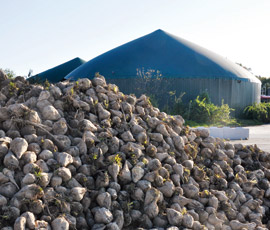Energy beet offers high methane yield for biogas

New trials show energy beet provides the highest dry matter and methane yield of any crop making it a perfect partner for maize in biogas plants.
The independent trials showed the best energy specific varieties produced 3t/ha more dry matter yield than the common variety Magnum. This equated to the equivalent of up to £500 of electricity being produced per cropped hectare.
The faster fermentation and fuel conversion means a mix of maize and beet allows producers to sustain high methane production in the biodigester over a prolonged period. This has seen a growing number of UK biogas producers now looking at using beet at up to 30% inclusion rates in their biodigesters.
Energy crop specialist at KWS, Simon Witheford, believes the significant increase in methane provided is a major boost towards maximising energy output per cropped area.
“After a year when maize has suffered due to lack of sunlight and heat units, growers in the UK are increasingly finding that energy beet helps provide yield stability as a more robust and reliable source of feedstock,” he says.
“After a year when maize has suffered due to lack of sunlight and heat units, growers in the UK are increasingly finding that energy beet helps provide yield stability as a more robust and reliable source of feedstock.”
Simon Witheford, KWS energy crop specialist
Mr Witheford also noted not only does it provide the highest dry matter and methane yield of any crop it can also be handled and stored as easily and cost-effectively as maize.
“Our experience is that beet is wholly complementary to maize or wholecrop cereals within the AD plant and with maize production unrealistic in some regions of the UK, it is providing a highly acceptable alternative”
“The two years of UK data shows that growers can easily produce energy beet dry matter yields on a par with those of specialist maize varieties,” he says.
One drawback in energy beet production is the ability to be able to get on the ground to plant and then harvest the crop, notes Mr Witheford.
Soils that are still at field capacity in mid-April and return to field capacity at around the end of October are seen to be more limited in their production.
However unlike maize, which needs to be harvested by a certain date, energy beet offers growers slightly more flexibility with no definite harvest date.
Other developments have seen KWS producing tolerant varieties to soil-borne pest beet cyst nematode (BCN). Areas where sugar beet has been widely grown are at risk of beet cyst nematode, which can reduce yields by up to 60%. However, the new variety Becky KWS offers tolerance to this.
More to biogas crops than yield per acre
